A few weeks ago, we covered the new Intel Atom C5000 series and the expanded Intel Atom P5000 series. With the new generations of chips, Intel is focusing on combining its efficient cores with high-speed networking and often acceleration. There are, however, many different features and it was a bit harder to figure out which SKU offers which feature, and sometimes at what performance level. We reached out to Intel, and can now share the feature guidance.
Intel Atom C5000 and P5000 Acceleration Including Networking and QAT
At the launch, all we had was the following table on the new SKUs with many “up tos” but not SKU specific guidance on the networking and QAT features:
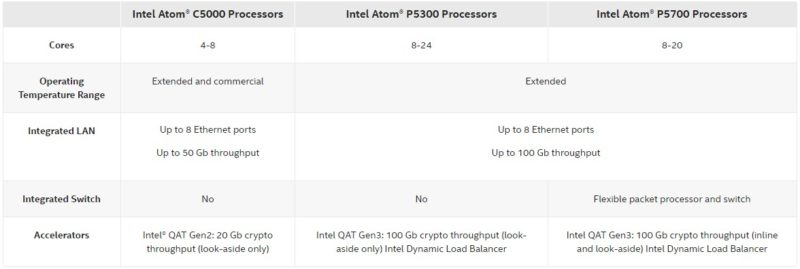
We reached out to Intel to see if we could get more detail on how this translates to actual SKU features. This is what we received from Intel on the new lines:
- Ethernet ports: All Atom C5000, P5300, and P5700 SKUs offer 8 ethernet ports, with the exception of C5115 and C5125 (these are storage-only SKUs)
- Max Ethernet Bandwidth:
- All Atom C5000 SKUs (sans C5115 and C5125, the storage-only SKUs) offer 50 Gb throughput
- All Atom P5300 SKUs offer 100 Gb throughput
- All Atom P5700 SKUs offer 100 Gb throughput, with the exception of the lower core count SKUs – P5721 and P5731 – which offer 50Gb throughput.
- Switching: Only the Atom P5700 SKUs have an integrated switch capable of 100 to 200 GbE packet processing.
- Atom P5752 and P5742 skus provide 200 GbE
- Atom P5721 and P5731 SKUs (lower core count) provide 100 GbE
- QAT speed:
- Atom C5000 SKUs integrate QAT Gen 2 capable of 10Gbps look-aside encryption throughput for the 4-core SKUs; 20Gbps for the 8-core SKUs.
- All Atom P5300 and P5700 SKUs integrate QAT Gen 3 with 100Gbps crypto throughput; P5700 SKUs offer both inline and lookaside. (Source: Intel e-mail to STH)
This is a great list as it explains which SKUs offer higher networking speeds. Here are the new Atom C5000 SKUs:

Here are the Intel Atom P5000 SKUs, but we will note that the above does not cover the older P5900B generation that was launched some time ago:
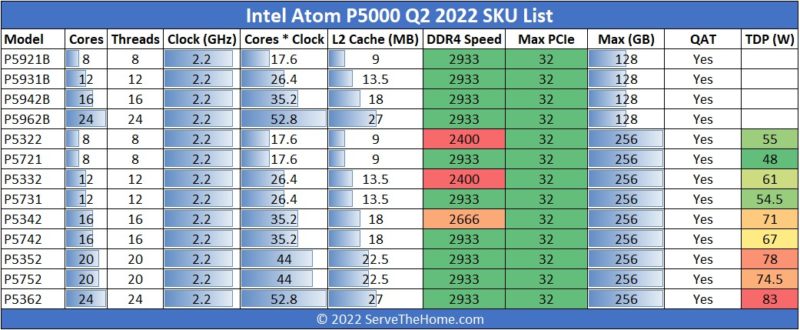
QAT is a feature we looked at back in 2017 in pieces like Intel QuickAssist Technology and OpenSSL and Intel QuickAssist at 40GbE Speeds: IPsec VPN Testing. There are multiple generations of QAT and QAT will be a bigger feature going forward. STH is working on more QAT content. The Gen 2 in the Atom C5000 and Gen 3 QAT in the Atom P5000 series is similar to the Intel Xeon D-2700 and D-1700 series that have both generations in use.
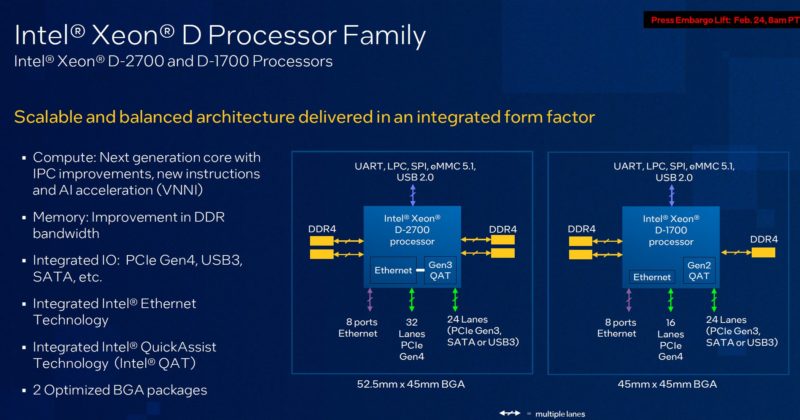
Here is the slide on Gen 3 Intel QuickAssist Technology from the Ice Lake-D launch:
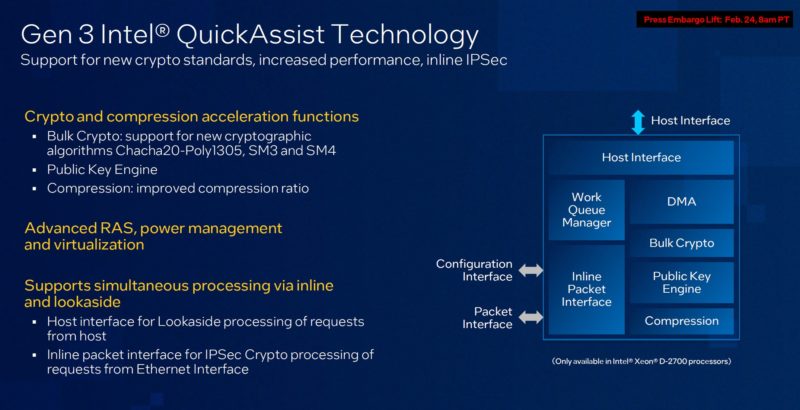
The Atom series was early in adopting QAT with Rangeley back in 2013. Almost 10 years later, it is becoming a more widely adopted acceleration technology.
Final Words
We hope the guidance we saw above helps our readers understand which acceleration and networking technologies are in the newest generation of Intel Atom C5000 and P5000 series processors. It is sometimes challenging to get this information, so we asked and now have guidance on what to expect. What we are more excited about is getting to test the new parts like the one in the cover image. Expect that to commence in a few weeks. In the meantime, we are going to be working on some QAT content in preparation for the feature to become more mainstream.

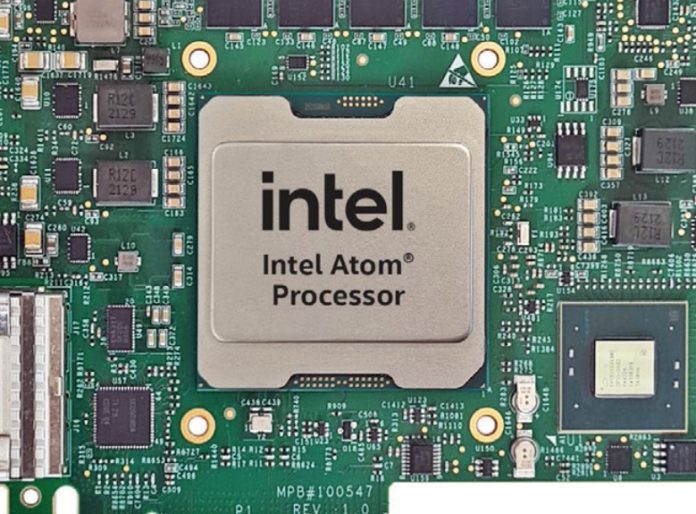



Maybe an idea for an article to provide a full lineup overview of all embedded parts. While previously choosing between Xeon-D and Atom seemed mostly a choice between power consumption and performance it looks much more muddy with the current gen. Not to mention that parts availability across the board is challenging.
Having some real world benchmarks of Atom C/P and Xeon-D parts would be really nice.
It seems kinda like a sucker’s bet that *this time* things will be different, and QAT will actually matter. The vast majority of people who bought into the promise since the c2xxx series paid more for lower clock speed and the vast majority never got any real functionality out of QAT. Odds are, the same will be true with this generation.
Mike – it has taken a LONG time, but 2023 will be QAT’s time to shine based on roadmaps. The performance is very good these days. We are going to have pieces this summer looking at a PCIe card version and then integrated in the new Xeon D-2700 series. 2023, there will be more QAT.
this look great to run tnsr, maybe will become homelab options (10g+)
Would definitely be interested in something like QAT to support high-speed VPN tunnels between on-prem networks an our cloud infrastructure.
We have a series coming up with the Coleto Creek QAT card with Ice Lake-SP and then the built-in Xeon D-2700 QAT.
I may just not be familiar enough with enterprise networking but how will the integrated switch be utilized? Is this for inner networking in virtualization or would you bridge a switch to somehow be managed by the Atom’s QAT?
One quarter short of a year since this announcement.
SuperMicro website still lists one of motherboards with these as “Coming Soon”.
Are Atom C5000 and P5000 even available in any retailed product at this date?
Edwin – we have purchased two in December/ Jan, for example the A3SPI-4C-LN6PF we reviewed.
So these are out there even if they say coming soon.